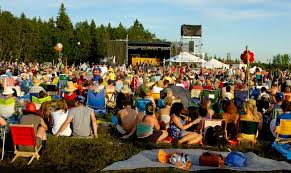Music Tourism

Music tourism is a significant and growing sector of tourism
. In the U.S. alone, music based tourism
constitutes approximately 17 percent of the tourism industry
and music festivals in particular are more
popular than ever, attracting millions of fans.
However, despite its significance, music tourism is still not
perceived as a defined segment within the tourism market, and
research exploring the dynamics of this burgeoning field is lacking
Music tourism involves individuals traveling to a place where
they do not reside to either listen to live performances or to
experience history related to the creation of or performance of
music . In the U.K. alone, music tourism generates
approximately $2 billion in spending and provides the equivalent of
19,700 full-time jobs. They include people like David Nye, of the
Great British Sausage Company, who sells around 41 miles worth of
sausages at music festivals around Britain each year and employs 20
students who host sausage-eating competitions to keep waiting
customers happy .
Music festivals themselves are a key component of music
tourism , and have been around for hundreds of
years. Most historians believe that they date back to Ancient Egypt
in 4500 BC, consisting of religious ceremonies and political fests
with music and dancing . Ancient Greece hosted its
first known music festival, the Pythian Games, during the sixth
century BC as a precursor to the Olympic Games, as well as holding
competitions for music and poetry. In more modern musical history, the Monterey Pop Festival in the summer of 1967 is considered
one of the most important landmarks for music festivals
. Occurring in June during the “Summer of Love”, this iconic
moment in music history shaped a generation and influenced
countless future artists. It was the coming out party for stars like
Jimi Hendrix, Janis Joplin, and Otis Redding. A few years later,
probably the most famous music festival of all time was staged e
Woodstock in 1969 e which prompted a crowd of over 400,000
people to travel by any means necessary to a small town in New
York for the festival.
 Social
media interactions with tourism brands, and specifically music
festival brands, affect how consumers think and feel about those
brands, and consequently how those interactions affect desired
marketing outcomes.
Social
media interactions with tourism brands, and specifically music
festival brands, affect how consumers think and feel about those
brands, and consequently how those interactions affect desired
marketing outcomes.
First, it explores whether existing customers who engage in brandrelated social media have more favorable brand perceptions and
behaviors than those who do not. Second, a conceptual model
captures the relationships between social media use, emotions,
brand perceptions, and word of mouth. Third, the study examines
the roles that emotional attachment and brand relationship quality
play in the context of social media use
Research examining the music festival sector tends to be
dominated by economic impact studies. UK Music for example,
commissioned a major study of the contribution of music festivals
and major concerts to tourism in the UK , and the
Northern Ireland Tourism Board conducted a similar study in
Northern Ireland in 2010 .
But some researchers have looked beyond the immediate economic
impacts. Haslam for example, comments that music festivals
offer potential as vehicles for branding cities, towns and villages, as
they can enhance a destination's image and identity, improving
perceptions of the place and the people that live there. Others have
studied the motivations of festival attendees. Campbellfor
instance, found a distinct connection between humans and music
in the context of human development, religion, politics and
sporting events, as well as the sense of place created by music
festivals.